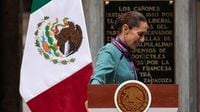Mexico has taken a bold step to protect its domestic industries and align itself more closely with its North American trade partners by proposing sweeping new tariffs on over 1,400 imported products, primarily from China and other Asian countries. The move, announced on September 10 and 11, 2025, comes amid mounting pressure from the United States to curb Chinese imports and ahead of the critical 2026 review of the U.S.-Mexico-Canada Agreement (USMCA).
According to the Associated Press, the proposed tariffs—embedded within Mexico’s 2026 budget plan—would affect a broad range of goods, including light vehicles, auto parts, textiles, shoes, plastics, electronics, toys, steel, and furniture. The new levies are set to reach as high as 50% for some items, with existing tariffs on certain products, such as Chinese automobiles, rising from 20% to the maximum allowed under World Trade Organization (WTO) rules.
Mexico’s Economy Minister, Marcelo Ebrard, outlined the rationale behind the tariffs: “They already have tariffs. What we will do is raise them to the maximum level allowed. Without a certain level of protection, you almost can’t compete.” Ebrard emphasized that the measures are intended to protect Mexican jobs, particularly as Chinese vehicles and other goods are entering the local market at prices “below what we call reference prices.”
The government estimates that the tariffs will cover $52 billion worth of imports, impacting approximately 8.6% of all goods Mexico buys from abroad. The affected countries include not only China, but also South Korea, India, Thailand, Indonesia, Russia, and Turkey—nations with which Mexico lacks free trade agreements. By contrast, countries such as the United States, Canada, Japan, and the European Union, all of which have trade deals with Mexico, will be exempt from the new levies.
President Claudia Sheinbaum, who recently delivered her first state-of-the-nation address, has insisted that the tariffs are not a direct response to U.S. demands but are designed to spur domestic production and address longstanding trade imbalances. “The tariffs are intended to counter the effects of U.S. tariffs on Mexican products, especially in the automotive sector, which accounts for 23% of Mexico’s manufacturing,” Sheinbaum said, as reported by AP. She also argued that many targeted products, such as Chinese cars, are sold at artificially low prices that threaten local manufacturers.
Still, the timing and scope of the tariffs suggest a clear alignment with U.S. trade policy. The United States has repeatedly accused China of using Mexico as a backdoor to access the American market, particularly as Washington has imposed its own steep tariffs—25% on Mexican automotive exports and 50% on steel and aluminum. According to Reuters, the U.S. is “not going to allow China to use Mexico as a backdoor,” reflecting a broader push to limit Beijing’s economic influence in Latin America.
Mexico’s governing party, which holds majorities in both chambers of Congress, is expected to easily pass the budget proposal. If approved, the tariffs will take effect 30 days after publication in Mexico’s official gazette, according to Bloomberg. The government argues that the measures will help protect up to 325,000 industrial and manufacturing jobs that are at risk due to foreign competition, particularly from Chinese manufacturers.
The new tariffs are also expected to have significant ripple effects on Mexico’s economy and consumer market. Analysts cited by Reuters and Bloomberg warn that higher levies on vehicles and other goods will likely drive up prices for Mexican consumers, reduce the range of available products, and limit competition. The automotive sector, in particular, stands to be heavily impacted, as Mexico has become the leading destination for Chinese-made vehicles—imports rose nearly 25% in the first half of 2025, surpassing even Russia.
Moreover, the tariffs could affect billions of dollars in investments tied to Chinese car brands and dealership networks in Mexico. According to Bloomberg, these investments total more than $3 billion and support over 32,000 direct jobs. The uncertainty surrounding the new trade measures may prompt some companies to reconsider or scale back their expansion plans in the country.
China, for its part, has condemned Mexico’s proposed tariffs in no uncertain terms. In August 2025, Chinese government spokesperson Guo Jiakun stated, “China firmly opposes restrictions imposed on China under various pretexts and under coercion from others, which harm China’s legitimate rights and interests.” On September 11, Lin Jian of China’s Foreign Ministry reiterated this position, saying, “We will resolutely safeguard our own rights and interests in accordance with the actual situation.” China is Mexico’s third-largest export destination and its second-largest source of imports, with bilateral trade totaling $130 billion in 2024.
Despite the diplomatic tensions, Mexican officials maintain that the tariffs are in line with international trade guidelines and are necessary to address the growing trade deficit with China, which has doubled over the past decade to reach $120 billion last year. Economy Secretary Ebrard stressed that the measures were crafted “within the guidelines of the World Trade Organization” and that the government would be sensitive to any impacts on production or consumer prices.
Some experts see the move as a strategic gambit by Mexico to strengthen its negotiating position ahead of the 2026 USMCA review. Oscar Ocampo, a researcher at the Mexican Institute for Competitiveness, told AP, “Mexico’s new tariffs on its Asian trade partners could strengthen its hand in talks with Washington.” Whether this strategy will succeed in securing tariff reductions or exemptions from the U.S. remains uncertain, but it signals Mexico’s intent to remain a key player in North American trade dynamics.
While the government’s stated goal is to bolster domestic industry and reduce reliance on foreign imports, the broader implications of the tariffs—on prices, investment, and international relations—are yet to fully unfold. As Mexico prepares for the upcoming USMCA review and continues its delicate balancing act between competing global powers, the new tariffs mark a significant, if contentious, shift in the country’s trade policy.
With the ruling party’s majority in Congress, the passage of the budget proposal—and the consequential tariffs—appears all but certain. The coming months will reveal how these measures reshape Mexico’s economic landscape, its relationships with major trading partners, and the daily lives of millions of Mexican consumers and workers.


